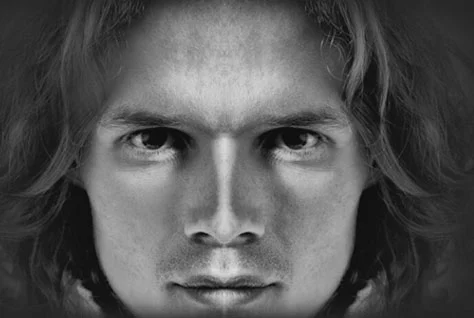In males, the eyebrows often have a flatter, less arched appearance compared to women, and this can influence how the aging process affects the overall eye area in men. The skin loses elasticity, resulting in sagging or drooping of the eyelids.

As men age, the upper eyelids tend to develop an overhanging layer of loose skin combined with protruding fat deposits, resulting in heaviness and hooding over the eyelids. In some cases, this condition can impact vision. Loose and redundant skin can affect the lower eyelids as well. Male blepharoplasty surgery, commonly referred to as male eyelid surgery, is specially tailored to target issues linked to the effects of aging on the appearance of the eyes.
The aging process causes a thinning of the supportive tissues in the male eyelids, leading to the protrusion of fat in the lower lid area and an excess of sagging skin. The skin around the eyes may lose firmness and develop wrinkles. Hooded eyelids occur when excess skin folds down from the brow line. Though the condition is often linked to aging, it may also be due to genetics. These changes often leave many men with a perpetually tired appearance.
Symptoms
Some of the most obvious aging symptoms that appear around the eyes:
- Hollow, puffy grooves
- Dark circles
- Under-eye bags and festoons (bags that develop beneath the bags)
- Fine lines and wrinkles
- Sagging, drooping skin due to unequal fat deposits and excess skin.
Blepharoplasty treats these concerns by removing excess skin, fat, or muscle to create a more refreshed and youthful look. Eyelid surgery can also address functional aspects of the eyes. The surgery can target the upper eyelid, the lower eyelid, or both. It can effectively address the following concerns:
- Correct sagging skin on the upper eyelid
- Reduce puffiness resulting from excess fatty tissue
- Address under-eye bags
- Elevate drooping eyelids
- Eliminate unwanted skin and fine lines on the lower eyelid
Say goodbye to tired, sagging eyes with blepharoplasty!
Call 212-265-2724 to schedule your consultation.
What Eyelid Surgery Involves
Blepharoplasty involves the precise removal or repositioning of excess skin, fat, and muscle, resulting in a refined and rejuvenated eye contour with a smoother, more youthful appearance.
Subtle incisions are strategically placed within the eyelid’s natural creases, ensuring that any resulting scarring remains inconspicuous. Sometimes the incision is extended to the laughter lines – the wrinkles or fine lines that typically form around the eyes and mouth as a result of smiling, laughing, and other facial expressions. In addition to removing excess fatty deposits, the naturally occurring localized fat is often repositioned. The remaining skin is then lifted and carefully sealed. This process results in a tighter and smoother appearance of the skin under the eyelid, ultimately providing patients with a more youthful and rejuvenated look. Once the excess skin and fat have been trimmed, the incisions are then closed with very fine sutures.
Complications are uncommon and vary depending on the technique utilized in the treatment. Depending on the extent of treatment, the patient’s needs, and whether they are having both eyes treated or just one, the process can take anywhere from one to two hours.
The procedure can be done using either local anesthesia with sedation or general anesthesia, prioritizing patient comfort throughout. Most patients experience only mild discomfort during the recovery phase, which can be effectively managed with the pain medication prescribed by the surgeon. After the surgery, it is common to experience some swelling and bruising around the eyes, and these temporary effects typically diminish within a few days.
Types of Blepharoplasty
Male blepharoplasty encompasses various types of eyelid surgeries tailored to address specific concerns or combine multiple enhancements. Here are some common types of male blepharoplasty:
Upper Eyelid Blepharoplasty
This procedure focuses on correcting sagging or drooping upper eyelids. It involves removing excess skin, repositioning or excising fat, and tightening the underlying muscles.
Lower Eyelid Blepharoplasty
Lower eyelid surgery primarily targets under-eye concerns such as puffiness, bags, and wrinkles. Surgeons can reposition or remove fat deposits and address excess skin to create a smoother lower eyelid contour.
Asian Eyelid Surgery
Also known as Asian blepharoplasty or double eyelid surgery, this type is tailored to Asian individuals who desire a more defined upper eyelid crease. It may involve creating or enhancing the crease.
Canthoplasty
Canthoplasty is often combined with upper or lower blepharoplasty. It involves altering the outer corner (canthus) of the eye to achieve a more youthful and balanced appearance.
Transconjunctival Blepharoplasty
This technique is used for lower eyelid surgery and involves making incisions on the inner side of the lower eyelid to access and address fat deposits without visible external scars.
Brow Lift with Blepharoplasty
Sometimes, male patients opt for a combination of brow lift and blepharoplasty to address both eyelid and forehead aging concerns, achieving overall facial harmony.
Revision Blepharoplasty
In cases where a previous eyelid surgery did not yield satisfactory results or created complications, revision blepharoplasty may be performed to correct or enhance the outcomes.
Male blepharoplasty surgery can enhance the appearance of the face by creating a more alert, youthful, and refreshed look. As with any cosmetic procedure, it’s important that you have realistic expectations and consult with a qualified and experienced surgeon to determine the most suitable approach for your specific needs.
Want to achieve a brighter, refreshed look?
Call 212-265-2724 now to learn about the transformative benefits of eyelid surgery
